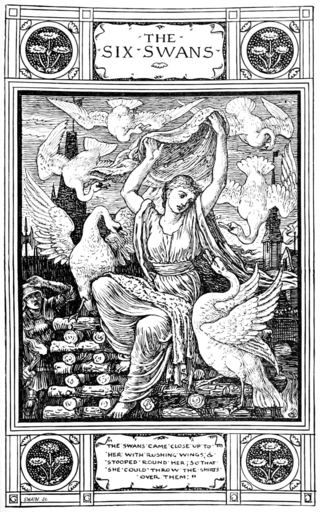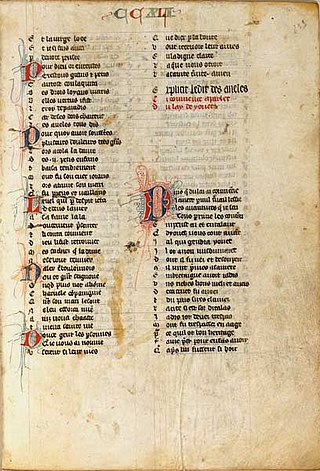Related Research Articles

"Cinderella", or "The Little Glass Slipper", is a folk tale with thousands of variants that are told throughout the world. The protagonist is a young girl living in forsaken circumstances who is suddenly blessed by remarkable fortune, with her ascension to the throne via marriage. The story of Rhodopis, recounted by the Greek geographer Strabo sometime between 7 BC and AD 23, about a Greek slave girl who marries the king of Egypt, is usually considered to be the earliest known variant of the Cinderella story.

In mythology, folklore and speculative fiction, shapeshifting is the ability to physically transform oneself through unnatural means. The idea of shapeshifting is found in the oldest forms of totemism and shamanism, as well as the oldest existent literature and epic poems such as the Epic of Gilgamesh and the Iliad. The concept remains a common literary device in modern fantasy, children's literature and popular culture. Examples of shapeshifters are vampires and werewolves.

The "swan maiden" story is a name in folkloristics used to refer to three kinds of stories: those where one of the characters is a bird-maiden, in which she can appear either as a bird or as a woman; those in which one of the elements of the narrative is the theft of the feather-robe belonging to a bird-maiden, though it is not the most important theme in the story; and finally the most commonly referred to motif, and also the most archaic in origin: those stories in which the main theme, among several mixed motifs, is that of a man who finds the bird-maiden bathing and steals her feathered robe, which leads to him becoming married to the bird-maiden. Later, the maiden recovers the robe and flies away, returning to the sky, and the man may seek her again. It is one of the most widely distributed motifs in the world, most probably being many millennia old, and the best known supernatural wife figure in narratives.

"The Six Swans" is a German fairy tale collected by the Brothers Grimm in Grimm's Fairy Tales in 1812. It is of Aarne–Thompson type 451, commonly found throughout Europe. Other tales of this type include The Seven Ravens, The Twelve Wild Ducks, Udea and her Seven Brothers, The Wild Swans, and The Twelve Brothers. Andrew Lang included a variant of the tale in The Yellow Fairy Book.

"The Juniper Tree" is a German fairy tale published in Low German by the Brothers Grimm in Grimm's Fairy Tales in 1812. The story contains themes of child abuse, murder, cannibalism and biblical symbolism and is one of the Brothers Grimm's darker and more mature fairy tales.

"The Master Maid" is a Norwegian fairy tale collected by Peter Christen Asbjørnsen and Jørgen Moe in their Norske Folkeeventyr. "Master" indicates "superior, skilled." Jørgen Moe wrote the tale down from the storyteller Anne Godlid in Seljord on a short visit in the autumn of 1842. Andrew Lang translated the tale to English and included it in his The Blue Fairy Book (1889). A later translation was made by George Dasent, in his Popular Tales from the North.
"Cap-o'-Rushes" is an English fairy tale published by Joseph Jacobs in English Fairy Tales.
Catskin is an English fairy tale collected by Joseph Jacobs in More English Fairy Tales. Marian Roalfe Cox, in her study of Cinderella, identified as one of the basic types, the Unnatural Father, contrasting with Cinderella itself and Cap O' Rushes.
The Rose-Tree is an English fairy tale collected by Joseph Jacobs in English Fairy Tales.

"The Blue Bird" is a French literary fairy tale by Madame d'Aulnoy, published in 1697. An English translation was included in The Green Fairy Book, 1892, collected by Andrew Lang.
The Fair Fiorita is an Italian fairy tale collected by Thomas Frederick Crane in Italian Popular Tales. Italo Calvino included a variant of it, The Princesses Wed to the First Passer-By, in his Italian Folktales.
"Nix Nought Nothing" is a fairy tale included in Joseph Jacobs's anthology, English Fairy Tales (1898). It is a translation of the Scottish tale "Nicht Nought Nothing", originally collected by Andrew Lang from an old woman in Morayshire, Scotland.

The Battle of the Birds is a Scottish fairy tale collected by John Francis Campbell in his Popular Tales of the West Highlands. He recorded it in 1859 from a fisherman near Inverary, John Mackenzie and was, at the time, building dykes on the Ardkinglas estate.
Gold-Tree and Silver-Tree is a Scottish fairy tale collected by Joseph Jacobs in his Celtic Fairy Tales. It is Aarne-Thompson type 709, Snow White. Others of this type include Bella Venezia, Nourie Hadig, La petite Toute-Belle and Myrsina.
"The Pig King" or "King Pig" is an Italian literary fairy tale written by Giovanni Francesco Straparola in his The Facetious Nights of Straparola. Madame d'Aulnoy wrote a French, also literary, variant, titled Prince Marcassin.

The Greek Princess and the Young Gardener is an Irish fairy tale collected by Patrick Kennedy in Fireside Stories of Ireland. Joseph Jacobs included it in More Celtic Fairy Tales.

"The Two Kings' Children" is a German fairy tale collected by the Brothers Grimm in Grimm's Fairy Tales, tale number 113.

"Yonec" is one of the Lais of Marie de France, written in the twelfth century by the French poet known only as Marie de France. Yonec is a Breton lai, a type of narrative poem. The poem is written in the Anglo-Norman dialect of Old French in rhyming couplets of eight syllables each. This lai tells the story of a woman who seeks to escape a loveless marriage, and of the child born from the love that she found elsewhere.
Tulisa, the Wood-Cutter's Daughter is an Indian legend published as an annex to Somadeva Bhaṭṭa's work, related to Cupid and Psyche.
The Golden Root or The Golden Trunk is a literary fairy tale written by Giambattista Basile in the Pentamerone, as the fourth story of the fifth day. It is considered to be one of two rewritings of the Graeco-Roman myth of "Cupid and Psyche" by Basile, the other being "Lo Catenaccio".
References
- ↑ Joseph Jacobs, English Fairy Tales, "Earl Mar's Daughter"